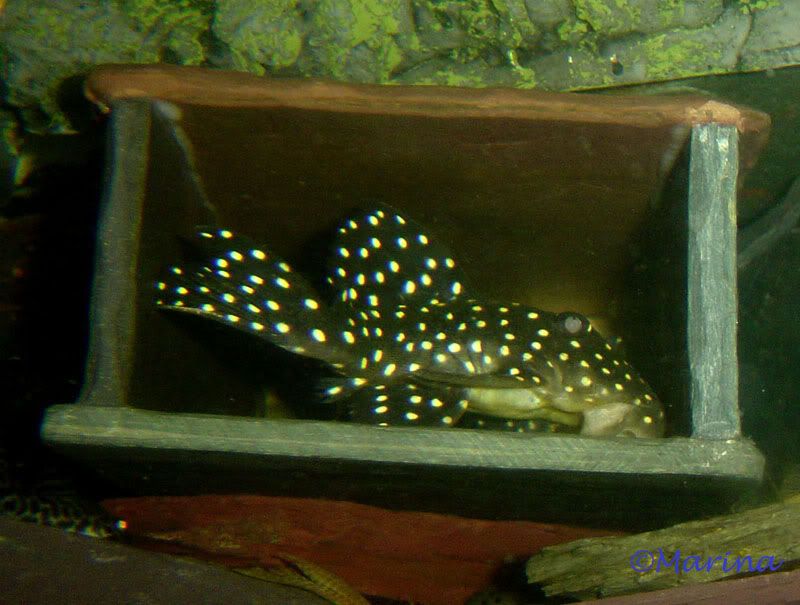Page 2 of 2
Posted: Sat Dec 03, 2005 10:25 am
by sharko
Caesars wrote:
check also the L82 - which is more rounded on the nose. Have you managed to see what its "teeth" / rasping plates look like? That usually is a good indication. If you get a chance can you get a couple of clear pictures of yours, dorsal view? But the head must show .. I got an idea

L82 look so long and narrow compared to mine, and the lower lip does not look much alike..compared to to pic of the mouth above...

Posted: Sat Dec 03, 2005 10:38 am
by Caesars
I have a Lepor sf Galaxias (L240) - its a stunning fish and yours is definately not that. While looking for a mate for it I got (through postage, hadn't seen the fish) two different fish - both as L007. Their colouration is different (one is more yellowish than the other) and the shape of their nose is very different (one is way longer and more pointed than the other). Having said that, the L007 is considered by some to be the same fish as the L29 (my supplier thinks one is the male and the other the female version of the same fish). I cannot comment on that as they haven't spawned yet, the younger is too young. I also have one that arrived from a new brazilian supplier (I was rather active looking for a mate for my L240

) - it was classified as Lepor Galaxias Blue Star - and that is a different fish too

All the fish that came as a Galaxias though have one thing in common - and that is they are quite "private" individuals and not the kind of fish you will see strolling about in the tank.
My experience with Hypancistrus is quite different - behaviourwise.
What I can confirm hand in heart is that the various Galaxias species I have (and I think I must be covering the range!!!

) don't look anything like Hypancistrus in shape - for starters the head is different. Thats why I asked if you could take a dorsal view pic of the fish ...
I still think its teeth would point us to the right direction - check the Aqualog for the teeth of L201.
PS I am expecting two new tanks in the next two weeks - if that hasn't been resolved by then I will take some pics as I take them out to re-house them and post them here for you to see

Posted: Sat Dec 03, 2005 3:45 pm
by Jools
Caesars wrote:I can't see the pictures very well .. and the commonality of the pattern is rather confusing, but as you have seen the fish does it look anything like this?


I'm fairly comfortable the original fish is L201. The fish above however - I'm pretty sure are a Scobinancistrus and that the lower one is a Leporacanthicus - more pics would tell for sure but they don't look the same to me.
Jools
Posted: Sat Dec 03, 2005 4:33 pm
by Caesars

@ the "original" fish Jools.
I agree with you, the top one of my fish doesn't look like a LDA31* as its growing. Its only a juvenile, I bought it as an LDA33 at 4 cm and its now about 8 - but I think it shapes up more like an L082 - what makes you think its a scobi?
As for the one you called Lepor - I just had it breeding!!! I would swear its an LDA33 - what do other people think? Which Lepor did you have in mind?
*EDIT: I meant LDA33 - there is something wrong with me and numbers lately

Posted: Sun Dec 04, 2005 2:07 pm
by inia
I think your pleco is L-201, his/her mouth looks like (tiny) Hypancistrus mouth to me. If the fish is behaving like a zebra (and not eating wood), it is L-201.
Posted: Sun Dec 04, 2005 4:59 pm
by McEve
Hi inia, did you mean that the Zebra don't eat wood? If you did that's not correct, I've seen mine do that on several occations. If that's not what you meant then just ignore this post

Posted: Tue Dec 06, 2005 5:42 pm
by sharko
So it is safe to say that the catfish in question is a Hypancistrus L201...
Posted: Tue Dec 06, 2005 7:15 pm
by inia
Hi inia, did you mean that the Zebra don't eat wood? If you did that's not correct, I've seen mine do that on several occations.
No, that was not what I ment, also my zebs (specially females and juveniles) eat wood sometimes, but not so passionately than for example Baryancistrus species do.


